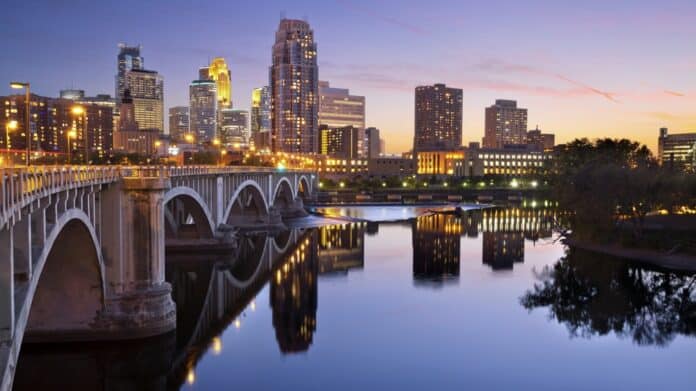
Residents of poor neighborhoods often struggle with higher crime rates, limited employment opportunities, lower school quality, and poor health outcomes. For those living on poverty level income, each of these factors reduces the likelihood of upward economic mobility.
The Duluth metro area has the worst extreme poverty in Minnesota, with 7.9% of residents living below the poverty line concentrated in high-poverty neighborhoods. Though the Mankato and St. Cloud metro areas have higher concentrated poverty, these cities are also home to major universities and large student populations — which can distort poverty measurements.
High-poverty areas typically have limited economic opportunities. In Duluth, labor force participants in the three neighborhoods with poverty rates of 40% or higher are more than twice as likely to be unemployed as those living in the rest of the city.
All data used in this story are five-year estimates from the U.S. Census Bureau’s 2019 American Community Survey. We only considered census tracts, or neighborhoods, with at least 500 people and college or graduate school enrollment below 50%. Metro areas were also excluded if over 25% of the population in tracts or neighborhoods of concentrated poverty were college or university students.
| Metro area with worst extreme poverty | Poor residents in high-poverty neighborhoods | Overall poverty rate | Overall poverty rate, statewide |
|---|---|---|---|
| Alabama: Tuscaloosa | 16.7% | 18.2% | 16.7% |
| Alaska: None | N/A | N/A | 10.7% |
| Arizona: Phoenix | 9.9% | 13.6% | 15.1% |
| Arkansas: Little Rock | 7.8% | 15.0% | 17.0% |
| California: Fresno | 28.5% | 22.5% | 13.4% |
| Colorado: Pueblo | 5.9% | 18.8% | 10.3% |
| Connecticut: New Haven | 12.7% | 11.7% | 9.9% |
| Delaware: None | N/A | N/A | 11.8% |
| Florida: Tallahassee | 21.5% | 15.8% | 14.0% |
| Georgia: Albany | 35.3% | 24.2% | 15.1% |
| Hawaii: None | N/A | N/A | 9.4% |
| Idaho: None | N/A | N/A | 13.1% |
| Illinois: Danville | 20.6% | 18.9% | 12.5% |
| Indiana: Muncie | 18.7% | 17.2% | 13.4% |
| Iowa: Waterloo | 9.6% | 13.4% | 11.5% |
| Kansas: Wichita | 5.7% | 13.0% | 12.0% |
| Kentucky: Louisville | 11.2% | 12.3% | 17.3% |
| Louisiana: Monroe | 49.5% | 24.2% | 19.2% |
| Maine: Lewiston | 13.5% | 11.8% | 11.8% |
| Maryland: Baltimore | 9.3% | 10.0% | 9.2% |
| Massachusetts: Springfield | 23.4% | 14.8% | 10.3% |
| Michigan: Flint | 32.4% | 18.9% | 14.4% |
| Minnesota: Duluth | 7.9% | 13.0% | 9.7% |
| Mississippi: Jackson | 21.3% | 16.9% | 20.3% |
| Missouri: Cape Girardeau | 27.9% | 16.4% | 13.7% |
| Montana: Great Falls | 19.8% | 13.3% | 13.1% |
| Nebraska: Omaha | 3.8% | 10.3% | 11.1% |
| Nevada: Las Vegas | 5.1% | 13.7% | 13.1% |
| New Hampshire: Manchester | 2.9% | 7.8% | 7.6% |
| New Jersey: Trenton | 21.3% | 11.7% | 10.0% |
| New Mexico: Las Cruces | 26.1% | 26.3% | 19.1% |
| New York: Buffalo | 27.4% | 14.0% | 14.1% |
| North Carolina: Goldsboro | 12.5% | 20.2% | 14.7% |
| North Dakota: None | N/A | N/A | 10.7% |
| Ohio: Toledo | 26.0% | 16.0% | 14.0% |
| Oklahoma: Oklahoma City | 9.2% | 13.7% | 15.7% |
| Oregon: Medford | 2.3% | 15.5% | 13.2% |
| Pennsylvania: Reading | 28.8% | 12.0% | 12.4% |
| Rhode Island: Providence | 4.0% | 12.0% | 12.4% |
| South Carolina: Columbia | 7.9% | 14.4% | 15.2% |
| South Dakota: None | N/A | N/A | 13.1% |
| Tennessee: Memphis | 24.6% | 17.5% | 15.2% |
| Texas: Laredo | 46.4% | 27.5% | 14.7% |
| Utah: None | N/A | N/A | 9.8% |
| Vermont: None | N/A | N/A | 10.9% |
| Virginia: Roanoke | 15.9% | 12.9% | 10.6% |
| Washington: Yakima | 8.5% | 17.4% | 10.8% |
| West Virginia: Huntington | 14.8% | 18.8% | 17.6% |
| Wisconsin: Milwaukee | 17.4% | 13.1% | 11.3% |
| Wyoming: None | N/A | N/A | 11.0% |


